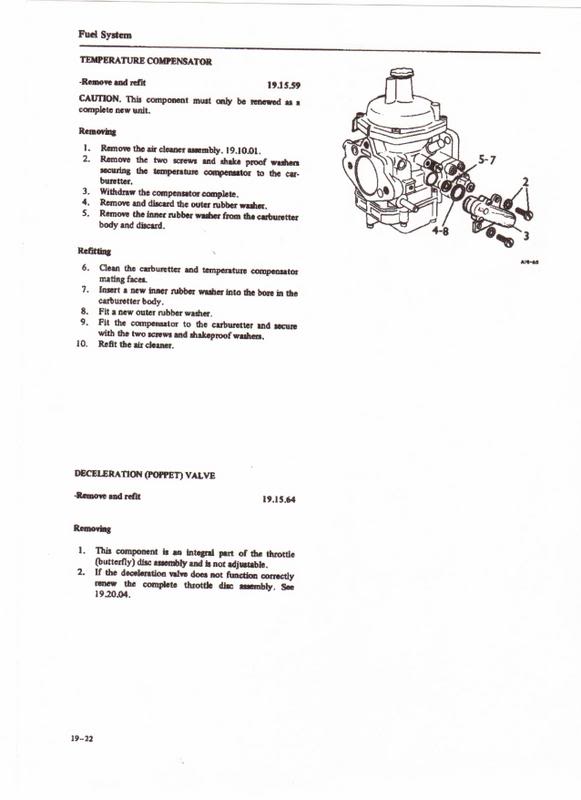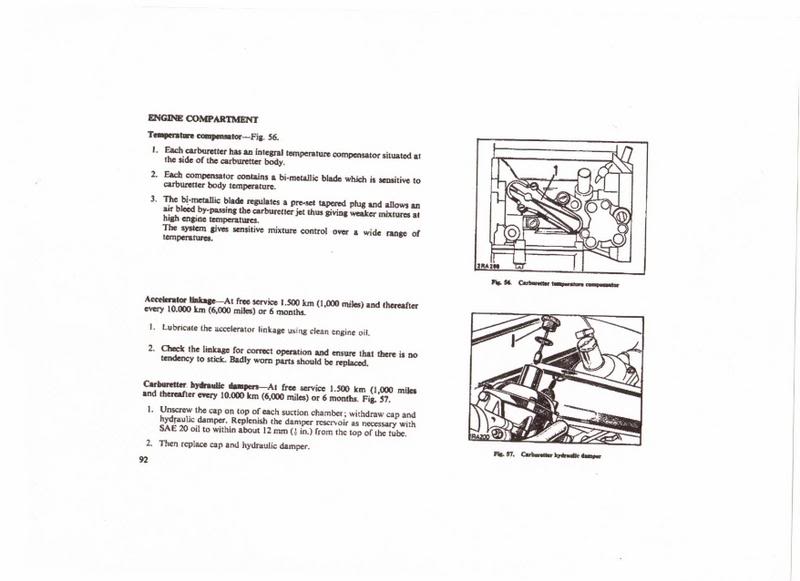Hi
Can anyone explain what the temperature compensators do and what is the effect if any are missing?
Bazza

Temperature Compensator
Started by
Bazza
, Jan 03 2007 02:59 PM
4 replies to this topic
#1

Posted 03 January 2007 - 02:59 PM
#2

Posted 03 January 2007 - 04:23 PM
there were some on ebay a while ago. i messaged this same question off to the seller.
heres the reply...
What exactly are Temperature Compensators?
To paraphrase the Haynes 'Zenith-Stromberg CD Carburettor' owners workshop manual:
"The temperature compensator (TC) is a rectangular housing with a plastic cover that contains a shaped bi-metallic strip, one end is secured to the housing with a screw or rivet, and an adjusting nut is located part-way along its length. The other end of the strip engages a plastic plunger with a conical end which slides in a cylindrical extension of the housing and thus forms a regulating valve.
Changes in temperature causes the bi-metallic strip to flex, moving the plunger in its bore, regulating the annular area around the bore thus controlling the amount of by-pass air that is allowed into the carburetors mixing chamber."
A common problem with the TC's is that the plastic cylindrical plunger becomes stuck, either open or closed due to build-up of gunk. There is also a rubber or fibre washer that swells with age and can partially (sometimes totally) block the air-bleed. When this happens the owner usually pulls the TC's apart, removes the bi-metallic strip, cleans off the gunk and puts it back together again. However in doing so, you must remove the adjusting nut, and unless you knew that the middle nut was an adjustment.....you were doomed.
The specifications on how to adjust the TC's were a closely guarded secret at the Zenith Carburettor factory and were never revealed to any known, living person!
First remove the bi-metallic strips. At room temperature they should be straight, however you may find yours bent because the DPO screwed down the nylock adjusting nut too much and bent them. After straightening, put them back together and gently tighten the adjusting nut until the plastic plunger just seals the opening in the cylindrical extension of the TC housing, then tighten it one more turn.
You now need to 'balance' multiple carb's and adjust the opening rate of the plastic plunger. This will take some trial and error, but will be worth the trouble. Fill a pan with water, put it on the stove, and place the TC's in the pan so they are completely covered in water and position them so you can observe the opening and closing of the plunger(s) together. Place a cooking thermometer in the water. Turn on the burner real low and observe what temperature the TC's start to open.
Based on much experimentation, I found that the plunger should not start to open until around 115F; at 125F it should be about half open, and at 140F the plunger should be fully open. This will introduce a fair amount of 'bypass' air into the mixing chamber when the ambient temperature is fairly warm (90F plus) - probably having to due with decreased air density as well. These should be taken as rough approximations at best, with probably a good 10F - 15F leeway. My experiments took into account cold starting, warm starting, carb needle adjustments (not being fully lean or rich), and general driveability for both in town and open road conditions.
When you have the TC's in the pan on the stove, keep a close eye on the water temp. If you need to adjust them, and you will, simply take them out of the water, run some cold tap water over them to cool them down, make the adjustment and put them back in the pan. They react very fast. To make the TC's open at a higher temperature, tighten the adjusting nut - about a 1/2 turn at a time. Most importantly you want the TC's to be balanced, i.e. open and close together at the same temperature.
After they are adjusted, put a drop of loctite on the exposed threads of the adjusting nut to keep the nut from moving. Don't move the nut, the loctite will 'seep' down into the nut enough to hold it. Also, check to make sure that the rubber sealing ring in the carburettor body that the nose of the TC's press up against is indeed there and in good shape. Same for the O-ring that goes around the 'snout' of the TC's and presses up against the outside of the carb body. If any of these are missing or cracked you will end up with a major air leak.
Some symptoms I have observed from not having enough bypass air is generally good driveability when cold and poor driveability when warm (if EVERYTHING else is in working order - ignition, timing, compression, etc) . Also overly rich mixture only when warm, difficult warm starting and needle mixture adjustment ineffective only when warm.
I also had the opportunity to test two brand new, unopened TC's that I came across. The two TC's opening/closing characteristics closely approximated my revised findings, however I was surprised (although not very) to observe a 20F - 25F variance in the opening/closing characteristics of these two TC's. Production tolerance?
However, based upon my testing, I believe that the most important operating parameter when dealing with TC's on a multi carb engine is to BALANCE the opening/closing temps and not the absolute temp that the TC's open or close.
Hopefully this will help.
sorry if this is too long, but i dont know hoe to put a link in from my desktop.
anyway hope this is what you were after.
cheers
heres the reply...
What exactly are Temperature Compensators?
To paraphrase the Haynes 'Zenith-Stromberg CD Carburettor' owners workshop manual:
"The temperature compensator (TC) is a rectangular housing with a plastic cover that contains a shaped bi-metallic strip, one end is secured to the housing with a screw or rivet, and an adjusting nut is located part-way along its length. The other end of the strip engages a plastic plunger with a conical end which slides in a cylindrical extension of the housing and thus forms a regulating valve.
Changes in temperature causes the bi-metallic strip to flex, moving the plunger in its bore, regulating the annular area around the bore thus controlling the amount of by-pass air that is allowed into the carburetors mixing chamber."
A common problem with the TC's is that the plastic cylindrical plunger becomes stuck, either open or closed due to build-up of gunk. There is also a rubber or fibre washer that swells with age and can partially (sometimes totally) block the air-bleed. When this happens the owner usually pulls the TC's apart, removes the bi-metallic strip, cleans off the gunk and puts it back together again. However in doing so, you must remove the adjusting nut, and unless you knew that the middle nut was an adjustment.....you were doomed.
The specifications on how to adjust the TC's were a closely guarded secret at the Zenith Carburettor factory and were never revealed to any known, living person!
First remove the bi-metallic strips. At room temperature they should be straight, however you may find yours bent because the DPO screwed down the nylock adjusting nut too much and bent them. After straightening, put them back together and gently tighten the adjusting nut until the plastic plunger just seals the opening in the cylindrical extension of the TC housing, then tighten it one more turn.
You now need to 'balance' multiple carb's and adjust the opening rate of the plastic plunger. This will take some trial and error, but will be worth the trouble. Fill a pan with water, put it on the stove, and place the TC's in the pan so they are completely covered in water and position them so you can observe the opening and closing of the plunger(s) together. Place a cooking thermometer in the water. Turn on the burner real low and observe what temperature the TC's start to open.
Based on much experimentation, I found that the plunger should not start to open until around 115F; at 125F it should be about half open, and at 140F the plunger should be fully open. This will introduce a fair amount of 'bypass' air into the mixing chamber when the ambient temperature is fairly warm (90F plus) - probably having to due with decreased air density as well. These should be taken as rough approximations at best, with probably a good 10F - 15F leeway. My experiments took into account cold starting, warm starting, carb needle adjustments (not being fully lean or rich), and general driveability for both in town and open road conditions.
When you have the TC's in the pan on the stove, keep a close eye on the water temp. If you need to adjust them, and you will, simply take them out of the water, run some cold tap water over them to cool them down, make the adjustment and put them back in the pan. They react very fast. To make the TC's open at a higher temperature, tighten the adjusting nut - about a 1/2 turn at a time. Most importantly you want the TC's to be balanced, i.e. open and close together at the same temperature.
After they are adjusted, put a drop of loctite on the exposed threads of the adjusting nut to keep the nut from moving. Don't move the nut, the loctite will 'seep' down into the nut enough to hold it. Also, check to make sure that the rubber sealing ring in the carburettor body that the nose of the TC's press up against is indeed there and in good shape. Same for the O-ring that goes around the 'snout' of the TC's and presses up against the outside of the carb body. If any of these are missing or cracked you will end up with a major air leak.
Some symptoms I have observed from not having enough bypass air is generally good driveability when cold and poor driveability when warm (if EVERYTHING else is in working order - ignition, timing, compression, etc) . Also overly rich mixture only when warm, difficult warm starting and needle mixture adjustment ineffective only when warm.
I also had the opportunity to test two brand new, unopened TC's that I came across. The two TC's opening/closing characteristics closely approximated my revised findings, however I was surprised (although not very) to observe a 20F - 25F variance in the opening/closing characteristics of these two TC's. Production tolerance?
However, based upon my testing, I believe that the most important operating parameter when dealing with TC's on a multi carb engine is to BALANCE the opening/closing temps and not the absolute temp that the TC's open or close.
Hopefully this will help.
sorry if this is too long, but i dont know hoe to put a link in from my desktop.
anyway hope this is what you were after.
cheers
#3

Posted 03 January 2007 - 04:41 PM
These are from my Rangie CD. It also says they are throw away and not servicable.


Hope this helps.


Hope this helps.
#4

Posted 03 January 2007 - 04:50 PM
Thanks lcgtr1979 and rodomo
I guess that tells me everything I need to know. 2 of my carbies have the TCs missing but they don't seem to be drawing air.
I saw the eBay items but I think it was only the white plastic covers on auction.
Does anyone know the downside of leaving them off. They seem to have been missing from my setup for a very long time. I presume they are readily available complete.
Bazza
I guess that tells me everything I need to know. 2 of my carbies have the TCs missing but they don't seem to be drawing air.
I saw the eBay items but I think it was only the white plastic covers on auction.
Does anyone know the downside of leaving them off. They seem to have been missing from my setup for a very long time. I presume they are readily available complete.
Bazza
#5

Posted 03 January 2007 - 04:59 PM
My reading of what it does is it leans the mixture off as the carby body warms up, more to do with pollution than economy I would think and wouldn't be worth worrying about unless the car is concourse condition. Even in that case the plastic covers with no guts and the holes plugged would "look" the part.
Edited by rodomo, 03 January 2007 - 05:02 PM.
0 user(s) are reading this topic
0 members, 0 guests, 0 anonymous users














